Abstract
This paper analyzes the usefulness of approximate addition for digital image compression. Discrete Cosine Transform (DCT) is an important operation in digital image compression. We used accurate addition and approximate addition individually while calculating the DCT to perform image compression. Accurate addition was performed using the accurate adder and approximate addition was performed using different approximate adders individually. The accurate adder and approximate adders were implemented in an application specific integrated circuit (ASIC)-type design environment using a 32–28 nm complementary metal oxide semiconductor (CMOS) standard cell library and in a field programmable gate array (FPGA)-based design environment using a Xilinx Artix-7 device. Error analysis was performed to calculate the error parameters of various approximate adders by applying one million random input vectors. It is observed that the approximate adders help to better reduce the file size of compressed images than the accurate adder. Simultaneously, the approximate adders enable reductions in design parameters compared to the accurate adder. For an ASIC-type implementation using standard cells, an optimum approximate adder achieved 27.1% reduction in delay, 46.4% reduction in area, and 50.3% reduction in power compared to a high-speed accurate carry look-ahead adder. With respect to an FPGA-based implementation, an optimum approximate adder achieved 8% reduction in delay and 19.7% reduction in power while requiring 47.6% fewer look-up tables (LUTs) and 42.2% fewer flip-flops compared to the native accurate FPGA adder.
1. Introduction
Approximate computing is an emerging computing technique that enables improvement in speed and reduction in power compared to accurate computing [1,2]. However, the improvement in performance comes at the cost of some loss in the accuracy and so it is important to guarantee an acceptable compromise between gains in performance and sacrifice in accuracy in approximate computing. Approximate computing has been considered for many practical applications such as multimedia [3], digital signal processing [4], big data and analytics [5], neuromorphic computing [6], neural networks for artificial intelligence and machine learning [7], software engineering [8], memory storage [9], low power graphics processing [10], etc. A significant amount of research on approximate computing has focused on the design of approximate arithmetic circuits such as approximate adders and multipliers [11]. This is understandable given that addition and multiplication are frequently encountered in processing units [12]. For example, it has been found that additions represent nearly 80% of the operations performed in an ARM’s arithmetic and logic unit [13], and adders and multipliers were found to contribute about 80% of the total power consumption of a fast Fourier transform processor [14].
This paper makes a comparative analysis of the efficacy of various approximate adders for a digital image compression application by replacing accurate addition in the DCT computation with approximate addition to determine an optimum approximation. Almurib et al. [15] implemented approximate DCT-based image compression; however, by considering three levels of processing, with the first level involving integer additions and, in some cases, logical right or left shifts, the second level filtering select frequencies which cannot be detected by human senses and the third level considering approximate adders to compute the DCT. However, in [15], only a few full-custom transistor level inaccurate full adders were considered to realize the inexact part; a simple and slow ripple carry adder was used to realize the exact part of an approximate adder and popular generic approximate adder topologies were ignored. In contrast, we considered utilizing generic approximate adder topologies involving a high-speed exact part and inexact parts, which are suitable for realization in both ASIC- and FPGA-based design environments. Our focus is on determining an optimum approximate adder architecture for DCT computation with respect to a digital image compression application. Besides, there are methods for approximate DCT computation in the literature, which have considered the use of low-complexity approximate matrices [16,17,18,19,20]. However, a discussion of these is beyond the focus and scope of this work.
The rest of this paper is organized as follows. Section 2 describes various approximate adder architectures. The performance of different approximate adders for digital image compression is discussed in Section 3. Section 4 gives the error metrics of approximate adders and the design parameters of accurate adder and approximate adders which were implemented in ASIC and FPGA design environments. Finally, Section 5 concludes the paper.
2. Approximate Adders
Approximate adders are broadly classified as static approximate adders and dynamic approximate adders. Static approximate adders incorporate a fixed approximation and generate deterministic sum outputs. Static approximate adders enable assured reductions in design parameters such as delay, power, and area compared to the accurate adder, however the performance gain is achieved at the expense of some compromise in the accuracy. Dynamic approximate adders incorporate a variable approximation and may produce accurate or approximate sum outputs based on need. However, to achieve this, dynamic approximate adders additionally employ an error detection and correction logic to evaluate and alter the error distance between the actual sum and the generated sum to adjust the approximation on the fly. However, the use of an additional error detection and correction logic in dynamic approximate adders and any associated increases in their computation cycles might become counterproductive to achieving significant reductions in their design parameters compared to the accurate adder. For a practical video encoding application, it was observed in [21] that the savings in power achieved by a dynamic approximate hardware is comparable to a static approximate hardware. This paper focuses on static approximate adders which are suitable for both ASIC- and FPGA-based implementations.
Static approximate adders typically have two parts, namely an exact part and an inexact part [4]. The inexact part processes least significant adder input bits and produces least significant sum output bits. The exact part processes more significant adder input bits and produces more significant sum output bits. In general, an N-bit adder is bi-partitioned such that P least significant input bit pairs are allocated to the inexact part and (N–P) more significant input bit pairs are allocated to the exact part. Accurate addition is performed in the exact parts of approximate adders while the logical operations performed in the inexact parts of approximate adders would depend on their respective architectures.
Figure 1 portrays block-level schematics of the accurate adder and various approximate adders which are considered for implementing image compression. to represent the most significant bit to the least significant bit of an N-bit adder input, and . to represent the most significant bit to the least significant bit of the other adder input.
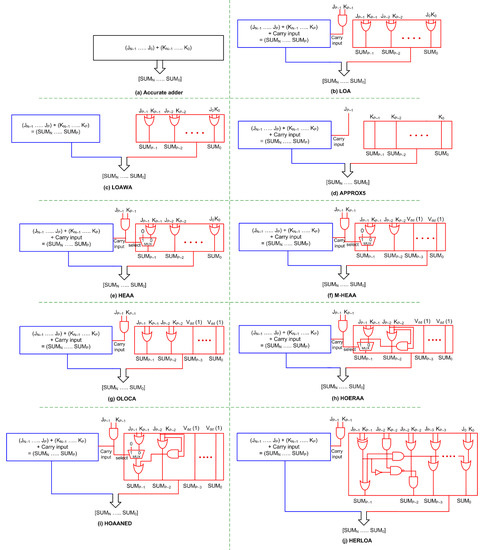
Figure 1.
Architectures of accurate adder and approximate adders: (a) accurate adder and (b–j) various approximate adders.
Figure 1a depicts the accurate adder which can be implemented using a high-speed adder architecture. The exact part of the approximate adders can also be implemented using a high-speed adder similar to the accurate adder. Figure 1b–j portrays N-bit approximate adders containing (N–P)-bit exact parts and P-bit inexact parts. In Figure 1b–j, the exact part is depicted in blue and comprises input bits ranging from to and to . The inexact part is depicted in red, which comprises input bits ranging from to and to . The exact part of an approximate adder may or may not receive a carry input from the inexact part depending upon its architecture.
In this paper, the accurate adder shown in Figure 1a and the exact part of the approximate adders shown in Figure 1b–j are realized using a high-speed carry look-ahead adder (CLA) [22] for an ASIC-type implementation, and using ahigh-speed native accurate FPGA adder for an FPGA-based implementation. Since the exact parts of the approximate adders are identical, the following discussion is only concerned with the inexact parts of the approximate adders shown in Figure 1.
Reference [23] presented a lower part OR approximate adder called LOA, shown in Figure 1b, where sum bits to are calculated by performing a bitwise-OR between the corresponding input bits. LOA performs bitwise AND between and of the inexact part to generate and provide a carry input to the exact part. Figure 1c shows another approximate adder [24], referred to as LOAWA in [25], which is similar to LOA but is different in that no carry input is provided from the inexact part to the exact part.
Reference [26] presented an approximate adder called APPROX5 in [25], which is shown in Figure 1d, which forwards input bits . up to as the respective sum bits to of the inexact part and supplies the input bit as the carry input to the exact part. Input bits . up to . are not used and discarded in APPROX5.
The approximate adder shown in Figure 1e viz. HEAA [27], as it is called in [25], performs bitwise-AND between . and ; if this results in binary 0, no carry input is provided to the exact part and the inexact part of HEAA would be the same as LOA and LOAWA; however, if binary 1 is the result, HEAA differs in that the sum bit . is set to 0, while the logic of the remaining sum bits from to would be the same as LOA and LOAWA. Figure 1f depicts M-HEAA [28] that is derived from an architectural modification of HEAA in which the (P–2) least significant sum bits of the inexact part are set to 1 while the rest of the logic of M-HEAA is the same as HEAA.
Approximate adder OLOCA [29], shown in Figure 1g, is obtained based on a modification of LOA in that the (P–2) least significant sum bits of the inexact part are set to 1 while the rest of the logic of OLOCA is the same as LOA.
Approximate adder HOERAA [25] is shown in Figure 1h, which features a carry input provided from the inexact part to the exact part that is the same as LOA, HEAA, M-HEAA, and OLOCA. As with M-HEAA and OLOCA, the (P–2) least significant sum bits of the inexact part are set to one in HOERAA. Sum bit is calculated by performing bitwise-OR between and . Sum bit is produced as the output of a 2:1 multiplexer (MUX), whose select input is the carry input given to the exact part. If the select input is 0, the logical-OR of and is produced as , and if the select input is 1, the logical-AND of and is produced as .
Approximate adder HOAANED [30] is shown in Figure 1i that also features a carry input supplied from the inexact part to the exact part similar to LOA, HEAA, M-HEAA, OLOCA, and HOERAA. The logic of up to of HOAANED is the same as M-HEAA, OLOCA, and HOERAA. As with HEAA, M-HEAA, and HOERAA, HOAANED also has a MUX in the logic corresponding to , whose select input is the carry input given to the exact part. If the MUX select input is 0, and are OR-ed and and are AND-ed, and these two are finally OR-ed to produce . On the contrary, if the MUX select input is 1, the logical AND of and is produced as .
Another approximate adder called HERLOA, presented in Reference [31], is shown in Figure 1j, which features a unique logic circuit used to produce the sum bits of the inexact part. However, the carry input supplied from the inexact part to the exact part has the same logic as LOA, HEAA, M-HEAA, OLOCA, HOERAA, and HOAANED.
In the next section, the performance of the accurate adder is compared with the performance of the approximate adders for digital image compression.
3. Digital Image Compression
Digital images of size 512 × 512 pixels with a grayscale resolution of 16-bits were considered for image compression using MATLAB. Figure 2 shows a block diagram illustrating the step-by-step procedure involved in JPEG-based image compression and recovery; the mathematical model underlying this procedure is discussed in [32] and we have used the same for this work.

Figure 2.
Block diagram illustration of JPEG-based image compression and recovery process.
An original digital image is first divided into a number of 8 × 8 image segment blocks. Next, the grayscale values of these 8 × 8 image segments are centred at zero; in other words, the 16-bit grayscale values are converted from a range of to to the range of to by subtracting from all the grayscale pixel values in the 8 × 8 image segment. The zero centering is required to ensure that, after performing a 2D discrete cosine transform (DCT), the lower frequency components would be present on the upper-left corner of the 8 × 8 segment and the higher frequency components would be present on the lower-right corner of the 8 × 8 segment. This is required to ensure that the essential information about an image is not lost during the quantization. The next stage involves the application of a 2D-DCT. During this stage, the multiples of sines and cosines and the sum of the multiples of sines and cosines are stored as constants, since the same values are used for all the 8 × 8 image segments. Accurate multiplication is performed to calculate the product of constant coefficients with the DCT inputs. The calculation of sum/difference of DCT inputs is performed using the accurate adder shown in Figure 1a and using the approximate adders shown in Figure 1b–j separately to comparatively analyze the performance of accurate adder and approximate adders based on the resulting quality of compressed images. The next step involves the element-wise division of each 8 × 8 block with the recommended 8 × 8 JPEG quantization matrix [33] to obtain the compressed image.
To recover the image from a compressed format, the reverse procedure is applied. De-quantization is followed by 2D inverse DCT (IDCT), which is performed by utilizing the built-in IDCT function in MATLAB for both the dimensions on 8 × 8 image segments, and then de-centering is performed by adding to convert the range of pixel values back to the range of 0 to ). Finally, the 8 × 8 image segments are merged to recover the original image in a visual form.
The sizes of accurate adder and approximate adders used for 2D-DCT calculation in image compression are 21-bits. While using 20-bit adders for image compression, a loss of information is observed due to a bit overflow that occurs during the addition. Therefore, 21-bits is found to be an optimum adder length for 16-bit digital image compression.
We considered the La Silla image [34] and the Black Hole image [35] for image compression, which are 16 × 3-bit RGB images imported from the European Southern Observatory database. Pre-processing is performed to convert the images into 16-bit 512 × 512 grayscale images before performing compression. The results of image compression and recovery using 21-bit accurate adder and approximate adders for 2D-DCT calculation for the 16-bit La Silla image are shown in Figure 3, Figure 4 and Figure 5. The compressed images obtained using the approximate adders, shown in Figure 3, Figure 4 and Figure 5, consider the use of 10-bits, 11-bits, and 12-bits, respectively, for the inexact part. In Figure 3, Figure 4 and Figure 5, the type of adder used, and the peak signal to noise ratio (PSNR) and structural similarity index metric (SSIM) of the compressed images, are mentioned along with the respective images for a ready reference.
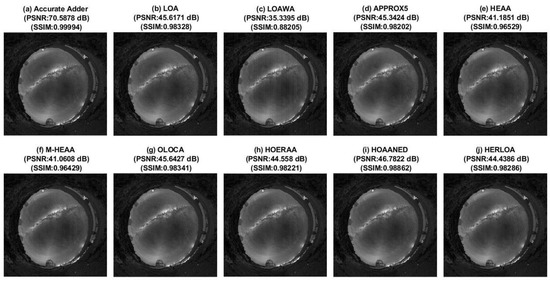
Figure 3.
La Silla image compressed using accurate adder and different approximate adders, with the approximate adders having a 10-bit inexact part.
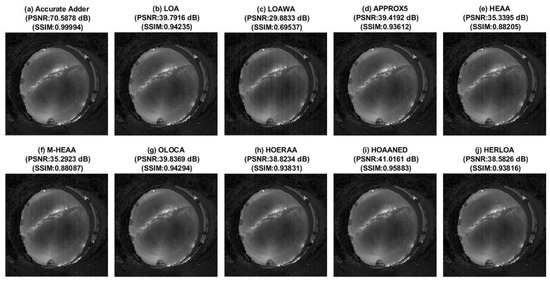
Figure 4.
La Silla image compressed using accurate adder and different approximate adders, with the approximate adders having an 11-bit inexact part.
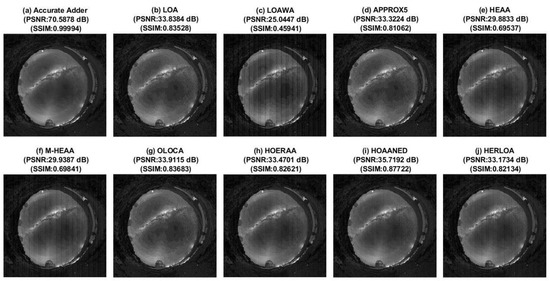
Figure 5.
La Silla image compressed using accurate adder and different approximate adders, with the approximate adders having a 12-bit inexact part.
PSNR [36] and SSIM [37] are widely used figures of merit in digital image processing. An image with less distortion, which is indicative of less noise, is preferable, as it would enable a high signal to noise ratio. For image processing, PSNR > 30 dB is generally considered to be preferable [36]. SSIM quantifies the structural similarity of an image of interest in comparison with a reference (original) image. SSIM could vary from decimal 0 to 1, with 0 indicating a complete mismatch and 1 indicating a complete match between the image of interest and the original image. Both PSNR and SSIM are preferred to be high for digital image processing.
The accurate adder recovers the original La Silla image and Black Hole image, with SSIM practically equal to 1, and this is due to the accurate computation. With respect to the La Silla image, Figure 3 shows many images of reasonably good quality, except for Figure 3c, which has a slight distortion.
Figure 4 showcases many images of acceptable quality with less distortion, except for Figure 4c,e,f. Although Figure 3 is preferable to Figure 4 overall, a higher approximation, which would also yield an acceptable output quality, is preferred, as that would lead to a greater reduction in the physical design parameters [25,30]. Thus, Figure 4 is said to represent an optimum approximation which is preferable, and Figure 3 is said to represent an under-approximation.
In Figure 5, except Figure 5a, which was obtained through accurate computation, the rest of the images from Figure 5b–j, which were obtained by approximate computation, are visibly more distorted compared to Figure 5a, and they are not of an acceptable quality. This is due to over-approximation, which is reflected in Figure 5.
In general, over-approximation cannot meet the desired output quality, therefore it is not preferred. Under-approximation would improve the accuracy/output quality (here, image quality), but would reduce the savings achievable in the design parameters, therefore it may not be preferable. Hence, an optimum approximation that would guarantee an acceptable accuracy while enabling optimum savings in the design parameters is preferable.
Figure 6, Figure 7 and Figure 8 portray the difference in pixel values (DPV) [36] between the La Silla image compressed using accurate and approximate adders and the original La Silla image. Figure 6, Figure 7 and Figure 8 correspond to approximate adders having 10-, 11-, and 12-bit inexact parts, respectively. In all the DPV plots, the difference between the respective pixel values of the original image and the compressed image is plotted on the x-axis, and the number of pixels associated with the corresponding DPV is plotted on the y-axis. Figure 6a, Figure 7a and Figure 8a are the same, which correspond to the image compressed using the accurate adder. In fact, the number of pixels having a zero DPV in Figure 6a, Figure 7a and Figure 8a compared to the original image is close to 6000. This is very high compared to the number of pixels with a zero DPV for the images compressed using different approximate adders. Hence, to precisely capture the DPV for images compressed using approximate adders, and to maintain a uniformity in the Y-axis scale, the Y-axis of the DPV plot corresponding to the accurate adder was curtailed. Nevertheless, this is not an issue, since the DPV plots of approximate adders are of interest and the DPV plot of the accurate adder is only shown for a visual comparison.
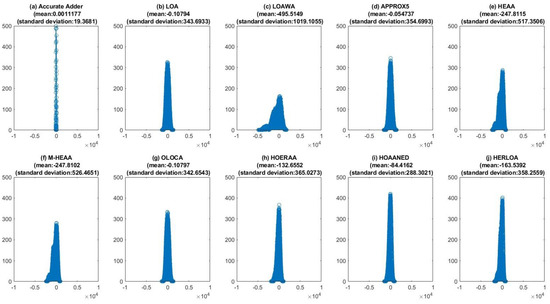
Figure 6.
Plots showing the difference in pixel values (DPV) between the La Silla image compressed using accurate and approximate adders and the original La Silla image, with the approximate adders having a 10-bit inexact part.
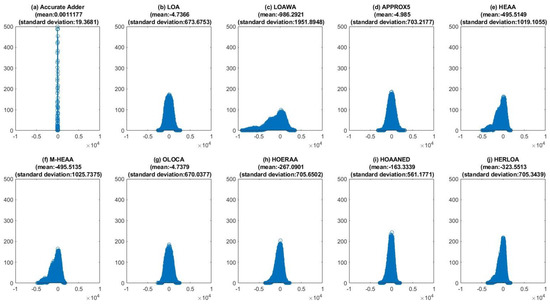
Figure 7.
Plots showing the DPV between the La Silla image compressed using accurate and approximate adders and the original La Silla image, with the approximate adders having an 11-bit inexact part.
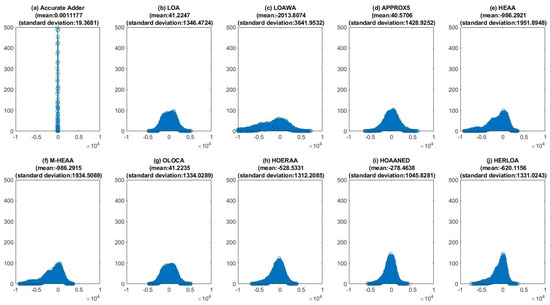
Figure 8.
Plots showing the DPV between the La Silla image compressed using accurate and approximate adders and the original La Silla image, with the approximate adders having a 12-bit inexact part.
Some important observations can be drawn from Figure 6, Figure 7 and Figure 8. Ideally, the image compressed using the accurate adder, shown in Figure 6a, Figure 7a and Figure 8a, should have zero mean and zero standard deviation; however, a very small mean (0.0011177) which is almost zero and a small standard deviation of 19.3681 result for the image compressed using the accurate adder compared to the original image. This is because JPEG image compression is basically a lossy compression technique, and so a negligible DPV manifests, which is the reason for a non-zero mean and a non-zero standard deviation of Figure 6a, Figure 7a and Figure 8a. While moving from Figure 6, Figure 7 and Figure 8, a flattening trend in the DPV plots of the approximate adders can be observed. This essentially implies that the number of pixels having a non-zero DPV increases with an increase in the approximation, which is rather obvious and is to be expected.
Figure 6, Figure 7 and Figure 8 uniformly show that the number of pixels having a zero DPV is greater for the images compressed using HOAANED (i.e., Figure 6i, Figure 7i and Figure 8i) compared to the images compressed using other approximate adders. Though the DPV plots corresponding to the images compressed using HERLOA (Figure 6j, Figure 7j and Figure 8j) have nearly the same number of pixels with a zero DPV as HOAANED, HOAANED consistently reports lower mean and standard deviation values compared to HERLOA for the different approximation scenarios. Hence, HOAANED is preferable to the other approximate adders, which is in agreement with the inference derived from Figure 3, Figure 4 and Figure 5.
The results of image compression and recovery using 21-bit accurate adder and approximate adders for 2D-DCT calculation for the 16-bit Black Hole image are shown in Figure 9, Figure 10 and Figure 11. The compressed images obtained using the approximate adders shown in Figure 9, Figure 10 and Figure 11 consider the use of 10-bits, 11-bits, and 12-bits, respectively, for the inexact part. In Figure 9, Figure 10 and Figure 11, the type of adder used and the PSNR and SSIM of the compressed images are mentioned along with the respective images for a ready reference.
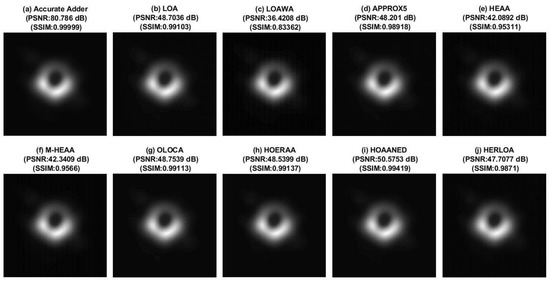
Figure 9.
Black Hole image compressed using accurate adder and different approximate adders, with the approximate adders having a 10-bit inexact part.
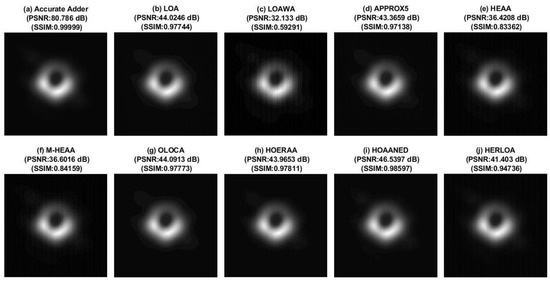
Figure 10.
Black Hole image compressed using accurate adder and different approximate adders, with the approximate adders having an 11-bit inexact part.
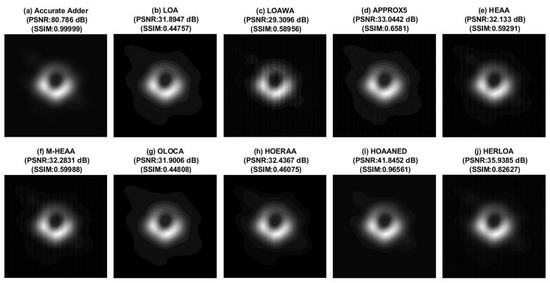
Figure 11.
Black Hole image compressed using accurate adder and different approximate adders, with the approximate adders having a 12-bit inexact part.
With respect to the Black Hole image, Figure 9 shows many images of reasonably good quality, except for Figure 9c,f, which has noticeable distortions. Figure 10 shows some images of acceptable quality with less distortion, except for Figure 10c,e,f. Although Figure 9 is preferable compared to Figure 10 overall, as mentioned previously, a higher approximation that would yield an acceptable output quality is preferable, as that would lead to a greater reduction in the design parameters after physical implementation. Hence, Figure 10 is said to represent an optimum approximation, which is preferable, while Figure 9 is said to represent an under-approximation. In Figure 11, except Figure 11a, which was obtained through accurate computation, the rest of the images from Figure 11b–j, which were obtained by approximate computation, are visibly more distorted compared to Figure 11a, and they are not of an acceptable quality. This is due to over-approximation, and Figure 11 reflects this condition. Given these, a 21-bit adder with an 11-bit inexact part is determined to be an optimum-approximation, i.e., acceptable approximation, and Figure 4 and Figure 10 correspond to an optimum approximation. Importantly, from Figure 4 and Figure 10, we note that HOAANED, referring to Figure 4i and Figure 10i, results in minimum error upon image recovery after compression and it facilitates higher PSNR and SSIM for the compressed images compared to the PSNR and SSIM of the compressed images obtained using other approximate adders. Hence, HOAANED is preferable to its counterparts.
Figure 12, Figure 13 and Figure 14 portray the DPV plots of the compressed Black Hole image using accurate and approximate adders in comparison with the original Black Hole image. Figure 12, Figure 13 and Figure 14 correspond to approximate adders having 10-, 11-, and 12-bit inexact parts respectively. Figure 12a, Figure 13a and Figure 14a are the same, which correspond to the image compressed using the accurate adder, and a non-zero mean and a non-zero standard deviation are associated with them due to the lossy JPEG image compression. In fact, the number of pixels that have a zero DPV in Figure 12a, Figure 13a and Figure 14a compared to the original image is found to be close to 20,000. This is much higher compared to the number of pixels that have a zero DPV for the images compressed using different approximate adders. Hence, to precisely capture the DPV for images compressed using various approximate adders, and to maintain a uniformity in the Y-axis scale, the Y-axis of the DPV plot corresponding to the accurate adder has been curtailed. Nevertheless, this is not an issue, since the DPV plots of approximate adders are of interest and the DPV plot of the accurate adder is only shown for a visual comparison. While moving from Figure 12, Figure 13 and Figure 14, a flattening trend in the DPV plots of the approximate adders can be observed, as observed in Figure 6, Figure 7 and Figure 8, which implies that the number of pixels that have a non-zero DPV increases with an increase in the approximation.
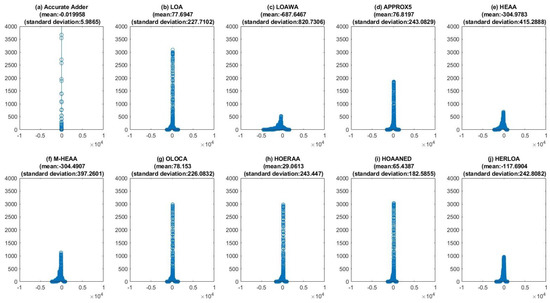
Figure 12.
Plots showing the DPV between the Black Hole image compressed using accurate and approximate adders and the original Black Hole image, with the approximate adders having a 10-bit inexact part.
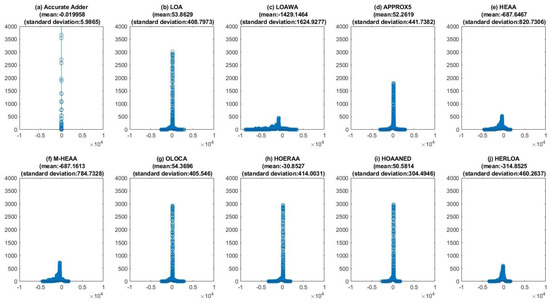
Figure 13.
Plots showing the DPV between the Black Hole image compressed using accurate and approximate adders and the original Black Hole image, with the approximate adders having an 11-bit inexact part.
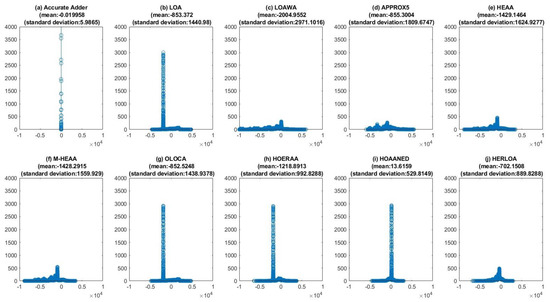
Figure 14.
Plots showing the DPV between the Black Hole image compressed using accurate and approximate adders and the original Black Hole image, with the approximate adders having a 12-bit inexact part.
Figure 12, Figure 13 and Figure 14 also uniformly show that the number of pixels that have a zero DPV is greater for the images compressed using HOAANED (i.e., Figure 12i, Figure 13i and Figure 14i) compared to the images compressed using other approximate adders. Hence, HOAANED is preferable to the other approximate adders for image compression, which is in agreement with the inference derived from Figure 9, Figure 10 and Figure 11.
The original size of the La Silla image before compression is 491 KB, and the original size of the Black Hole image before compression is 379 KB. The impact of compression on La Silla and Black Hole images using a 21-bit accurate adder and different 21-bit approximate adders with an 11-bit inexact part is presented in Table 1. While almost all of the approximate adders enable good image compression than the accurate adder, a relatively better image compression is achieved using HOAANED, which is substantiated by the high PSNR and SSIM attained, which is evident from Figure 3, Figure 4, Figure 5, Figure 9, Figure 10 and Figure 11

Table 1.
Compressed file sizes of La Silla and Black Hole images corresponding to accurate adder and various approximate adders comprising an 11-bit inexact part.
Referring to Table 1 and Figure 4a,i and Figure 10a,i, we note that the La Silla image compressed using HOAANED has a 10.2% smaller file size than the image compressed using the accurate adder, and the Black Hole image compressed using HOAANED has a 70.2% smaller file size than the image compressed using the accurate adder. Typically, when JPEG compression is performed using DCT, very high frequency information which cannot be easily distinguished by a human eye is lost, which results in a lossy compression. This high frequency information loss is more pronounced in the case of the Black Hole image compared to the La Silla image, which is the likely reason for the greater compression achieved for the Black Hole image.
4. Error Metrics and Design Parameters of Approximate Adders
In the previous section, it was noted that the image compression of a 21-bit approximate adder with an 11-bit inexact part represents an acceptable/optimum approximation. Given this, we supplied one million randomly generated input vectors to the accurate adder and approximate adders to calculate their respective sums and subsequently estimate the error. We calculated popular error metrics such as the mean error distance/mean absolute error (MAE) and root mean square error (RMSE) of the approximate adders. MAE and RMSE were calculated using Equations (1) and (2), respectively [38], given below, where L is the number of random input vectors that is equal to one million. In Equations (1) and (2), denotes the sum produced by an approximate adder and denotes the sum produced by the accurate adder. Table 2 gives MAE and RMSE values corresponding to different 21-bit approximate adders with an 11-bit inexact part. Less MAE and RMSE are observed for HERLOA compared to the other approximate adders. However, HOAANED has a near-normal error distribution [30], since its positive and negative error magnitudes almost cancel out, which is the reason for its practically zero average error.

Table 2.
Error metrics calculated for approximate adders for a size of 21-bits with a 11-bit inexact part.
The accurate adder and approximate adders were implemented in ASIC- and FPGA-based design environments, and their design parameters were estimated to make a comparison. The ASIC-type implementation utilized the gates of a 32–28 nm CMOS standard cell library [39]. A typical case high Vt library specification with a supply voltage of 1.05 V and an operating junction temperature of 25 ℃ was considered. Fanout-of-4 drive strength was applied on all the output ports, i.e., the sum bits, and default wire loads were considered. Synthesis, simulation, and estimation of the design parameters were performed using Synopsys EDA tools.
The accurate adder and various approximate adders were first described structurally in Verilog HDL and then synthesized using Design Compiler with speed set as the optimization goal. Functional simulations were performed using VCS by supplying a test bench consisting of about one thousand randomly generated input vectors, which were supplied at a data rate of 1 ns, i.e., 1 GHz. The total (average) power dissipation was estimated by taking into account the switching activity which was captured during functional simulation. PrimeTime, PrimePower, and Design Compiler were used to estimate the critical path delay, total power dissipation, and total area (cells area plus interconnect area) of the adders.
Structurally, a half-adder and five 4-bit CLAs were used to describe a 21-bit accurate adder, while a 2-bit CLA without/with the carry input and two 4-bit CLAs were used to describe the 10-bit exact parts of approximate adders. The CLA design presented in [22] was used to realize the accurate adder and the exact parts of the approximate adders for an ASIC-based implementation. The standard design parameters estimated are given in Table 3. Table 3 reports a significant decrease in delay, area, and power dissipation for the approximate adders compared to the accurate adder. Since the approximate adders have only a 10-bit exact part in contrast to the accurate adder, which is of size 21 bits, their critical path delay would therefore be substantially less. All the approximate adders have the same-sized inexact part, therefore their critical path delay would typically be the same. The logic design of the inexact parts of approximate adders differs, therefore some differences manifest in their area and power dissipation. Nevertheless, since the logic of the inexact parts of approximate adders is reduced compared to the accurate adder, they potentially occupy less area and dissipate less power, as seen in Table 3. In the previous section, HOAANED was stated to be preferable for image compression, and, from Table 3, it is found to achieve a 27.1% reduction in delay, 46.4% reduction in area, and 50.3% reduction in power compared to the accurate CLA.

Table 3.
Design parameters of accurate and approximate 21-bit adders corresponding to an ASIC-type implementation; the approximate adders have an 11-bit inexact part.
For an FPGA implementation, the accurate adder and approximate adders were described behaviorally in Verilog HDL and synthesized and implemented on an Artix-7 FPGA (Xilinx part: xc7a100tcsg324-3) using Xilinx Vivado design tool (version: 2018.3). The addition operator was used to describe the accurate adder and the exact parts of the approximate adders—this resulted in the utilization of the fast carry logic embedded in an FPGA slice to realize the accurate adder and the exact parts of the approximate adders for high-speed. The ‘Flow_AreaOptimized_high’ strategy was used for synthesis and the default implementation strategy was used. A pair of registers was provisioned before the adder’s inputs and a register was provisioned following the adder’s outputs. The pair of registers before the adder’s inputs help to isolate the adders from the physical inputs-outputs, and this helps to avoid input-output delay and input-output routing delay from impacting the adder’s speed. The estimated FPGA design parameters such as minimum clock period (equivalent to critical path delay), total on-chip power consumption, and the number of LUTs and flip-flops (also called registers) are given in Table 4.

Table 4.
FPGA-based design parameters of accurate and approximate 21-bit adders; the approximate adders have an 11-bit inexact part.
Similar to Table 3, Table 4 also shows a reduction in the design parameters of approximate adders compared to the accurate adder for the same reasons discussed previously. The reduced exact part of the approximate adders compared to the accurate adder leads to a reduction in their minimum clock period. The reduced logic of the inexact part of the approximate adders results in less resource consumption (fewer LUTs and/or registers) and less on-chip power compared to the accurate FPGA adder. As HOAANED was observed to be preferable for image compression in Section 3, from Table 4, it is noted that HOAANED achieves an 8% reduction in delay, 19.7% reduction in power, and requires 47.6% less LUTs and 42.2% less registers compared to the accurate native FPGA adder.
Usually, the product of power and delay (PDP) is computed as a generic figure of merit to quantify the low power/energy efficiency of a digital logic design. The smaller the values of power and delay are, the more desirable; therefore, PDP is also desirable to be less for a digital logic design. Given this, we calculated the PDP for the ASIC- and FPGA-based implementations of accurate adder and approximate adders and normalized them. To normalize the PDP, the highest PDP (which pertains to the accurate adder) is considered as the reference, and this reference was used to divide the PDPs calculated for the accurate adder and the approximate adders. This procedure was followed to normalize the PDPs of ASIC- and FPGA-based implementations separately, and the normalized PDP plots of accurate adder and approximate adders are shown in Figure 15, which reflect a similar trend. Given that HOAANED is preferable (as noted from Section 3), it achieves a 26.1% reduction in PDP compared to the accurate adder for an FPGA-based implementation and a 63.8% reduction in PDP compared to the accurate CLA for an ASIC-type implementation.
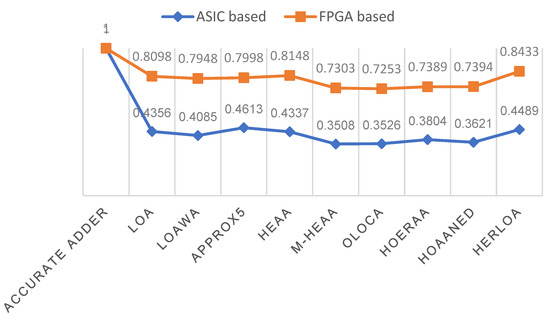
Figure 15.
Normalized PDP of accurate and approximate adders corresponding to ASIC- and FPGA-based implementations.
5. Conclusions
This paper has analyzed the utility of approximate adders for a digital image compression application. The results show that approximate adders reduce the size of compressed images better compared to the accurate adder while enabling significant reductions in the design parameters for both FPGA- and ASIC-based implementations. Among the approximate adders, HOAANED is found to be preferable, and this could be attributed to its near-normal error distribution characteristic. The La Silla image compressed using HOAANED has a 10.2% smaller file size than the compressed image file obtained using the accurate adder, and the Black Hole image compressed using HOAANED has a 70.2% smaller file size than the compressed image file obtained using the accurate adder. This is achieved with La Silla and Black Hole images compressed using HOAANED having PSNR > 40 dB and SSIM > 0.95, which are acceptable. For an ASIC-type implementation using standard cells, HOAANED achieved a 27.1% reduction in delay, 46.4% reduction in area, and 50.3% reduction in power compared to a high-speed accurate CLA. For an FPGA-based implementation, HOAANED achieved 8% reduction in delay and 19.7% reduction in power while requiring 47.6% fewer LUTs and 42.2% fewer registers compared to the high-speed accurate FPGA adder.
Author Contributions
Conceptualization, P.B. and R.N.; methodology, P.B. and R.N.; software, P.B. and R.N.; validation, P.B. and R.N.; investigation, P.B. and R.N.; resources, D.L.M.; data curation, P.B. and R.N.; writing—original draft preparation, P.B. and R.N.; writing—review & editing, P.B.; visualization, P.B. and R.N.; supervision, P.B. and D.L.M.; project administration, P.B. and D.L.M.; funding acquisition, D.L.M. All authors have read and agreed to the published version of the manuscript.
Funding
This research was funded by the Ministry of Education (MOE), Singapore under Academic Research Fund Tier-2 grant number MOE2018-T2-2-024.
Data Availability Statement
All data are available within the manuscript.
Conflicts of Interest
The funders had no role in the design of the study; in the collection, analyses, or interpretation of data; in the writing of the manuscript, or in the decision to publish the results.
References
- Han, J.; Orshansky, M. Approximate computing: An emerging paradigm for energy-efficient design. In Proceedings of the 18th IEEE European Test Symposium, Avignon, France, 27–31 May 2013. [Google Scholar]
- Venkataramani, S.; Chakradhar, S.T.; Roy, K.; Raghunathan, A. Approximate computing and the quest for computing efficiency. In Proceedings of the 52nd Design Automation Conference, San Francisco, CA, USA, 8–12 June 2015. [Google Scholar]
- Breuer, M.A.; Zhu, H. Error-tolerance and multi-media. In Proceedings of the International Conference on Intelligent Information Hiding and Multimedia Signal Processing, Pasadena, CA, USA, 18–20 December 2006. [Google Scholar]
- Zhu, N.; Goh, W.L.; Zhang, W.; Yeo, K.S.; Kong, Z.H. Design of low-power high-speed truncation-error-tolerant adder and its application in digital signal processing. IEEE Trans. VLSI Syst. 2010, 18, 1225–1229. [Google Scholar]
- Nair, R. Big data needs approximate computing: Technical perspective. Commun. ACM 2015, 58, 104. [Google Scholar] [CrossRef]
- Panda, P.; Sengupta, A.; Sarwar, S.S.; Srinivasan, G.; Venkataramani, S.; Raghunathan, A.; Roy, K. Cross-layer approximations for neuromorphic computing: From devices to circuits and systems. In Proceedings of the 53rd Design Automation Conference, Austin, TX, USA, 5–9 June 2016. [Google Scholar]
- Sarwar, S.S.; Srinivasan, G.; Han, B.; Wijesinghe, P.; Jaiswal, A.; Panda, P.; Raghunathan, A.; Roy, K. Energy efficient neural computing: A study of cross-layer approximations. IEEE J. Emerg. Sel. Top. Circuits Syst. 2018, 8, 796–809. [Google Scholar] [CrossRef]
- Sampson, A.; Deitl, W.; Fortuna, D.; Gnanapragasam, D.; Ceze, L.; Grossman, D. EnerJ: Approximate data types for safe and general low-power computation. ACM Sigplan Not. 2011, 46, 164–174. [Google Scholar] [CrossRef]
- Sampson, K.; Nelson, J.; Strauss, K.; Ceze, L. Approximate storage in solid-state memories. ACM Trans. Comput. Syst. 2014, 32, 1–23. [Google Scholar] [CrossRef]
- Zhang, H.; Putic, M.; Lach, J. Low power GPGPU computation with imprecise hardware. In Proceedings of the 51st Design Automation Conference, San Francisco, CA, USA, 1–5 June 2014. [Google Scholar]
- Jiang, H.; Liu, C.; Liu, L.; Lombardi, F.; Han, J. A review, classification, and comparative evaluation of approximate arithmetic circuits. ACM J. Emerg. Technol. Comput. Syst. 2017, 13, 1–37. [Google Scholar] [CrossRef]
- Hennessy, J.; Patterson, D. Computer Architecture: A Quantitative Approach, 5th ed.; Morgan Kaufmann: Burlington, MA, USA, 2003; ISBN 9780123838735. [Google Scholar]
- Garside, J.D. A CMOS VLSI implementation of an asynchronous ALU. In Proceedings of the IFIP Working Conference on Asynchronous Design Methodologies, Manchester, UK, 31 March–2 April 1993. [Google Scholar]
- Wanhammar, L. DSP Integrated Circuits, 1st ed.; Academic Press: Cambridge, MA, USA, 1999; ISBN 9780127345307. [Google Scholar]
- Almurib, H.A.F.; Nandha Kumar, T.; Lombardi, F. Approximate DCT image compression using inexact computing. IEEE Trans. Comput. 2018, 67, 149–159. [Google Scholar] [CrossRef]
- Bouguezel, S.; Ahmad, M.O.; Swamy, M.N.S. Low-complexity 8×8 transform for image compression. Electron. Lett. 2008, 44, 1249–1250. [Google Scholar] [CrossRef]
- Cintra, R.J.; Bayer, F.M. A DCT approximation for image compression. IEEE Signal Process. Lett. 2011, 18, 579–582. [Google Scholar] [CrossRef]
- Potluri, U.S.; Madanayake, A.; Cintra, R.J.; Bayer, F.M.; Kulasekara, S.; Edirisuriya, A. Improved 8-point approximate DCT for image and video compression requiring only 14 additions. IEEE Trans. Circuits Syst. I Regul. Pap. 2014, 61, 1727–1740. [Google Scholar] [CrossRef]
- Da Silveira, T.L.T.; Bayer, F.M.; Cintra, R.J.; Kulasekara, S.; Madanayake, A.; Kozakevicius, A.J. An orthogonal 16-point approximate DCT for image and video compression. Multidimens. Syst. Signal Process. 2016, 27, 87–104. [Google Scholar] [CrossRef][Green Version]
- Huang, J.; Nandha Kumar, T.; Almurib, H.A.F.; Lombardi, F. A deterministic low-complexity approximate (multiplier-less) technique for DCT computation. IEEE Trans. Circuits Syst. I Regul. Pap. 2019, 66, 3001–3014. [Google Scholar] [CrossRef]
- Raha, A.; Jayakumar, H.; Raghunathan, V. Input-based dynamic reconfiguration of approximate arithmetic circuits for video encoding. IEEE Trans. VLSI Syst. 2016, 24, 846–857. [Google Scholar] [CrossRef]
- Balasubramanian, P.; Maskell, D.L. Factorized carry lookahead adders. In Proceedings of the IEEE 14th International Symposium on Signals, Circuits and Systems, Iasi, Romania, 11–12 July 2019. [Google Scholar]
- Mahdiani, H.R.; Ahmadi, A.; Fakhraie, S.M.; Lucas, C. Bio-inspired computational blocks for efficient VLSI implementation of soft-computing applications. IEEE Trans. Circuits Syst. I Regul. Pap. 2010, 57, 850–862. [Google Scholar] [CrossRef]
- Albicocco, P.; Cardarilli, G.C.; Nannarelli, A.; Petricca, M.; Re, M. Imprecise arithmetic for low power image processing. In Proceedings of the 46th Asilomar Conference on Signals, Systems and Computers, Pacific Grove, CA, USA, 4–7 November 2012. [Google Scholar]
- Balasubramanian, P.; Maskell, D.L. Hardware optimized and error reduced approximate adder. Electronics 2019, 8, 1212. [Google Scholar] [CrossRef]
- Gupta, V.; Mohapatra, D.; Raghunathan, A.; Roy, K. Low-power digital signal processing using approximate adders. IEEE Trans. Comput. Aided Des. Integr. Circuits Syst. 2013, 32, 124–137. [Google Scholar] [CrossRef]
- Balasubramanian, P.; Maskell, D.L. Hardware efficient approximate adder design. In Proceedings of the IEEE Region 10 Conference, Jeju, Korea, 28–31 October 2018. [Google Scholar]
- Balasubramanian, P.; Maskell, D.L.; Prasad, K. Approximate adder with reduced error. In Proceedings of the IEEE 31st International Conference on Microelectronics, Nis, Serbia, 16–18 September 2019. [Google Scholar]
- Dalloo, A.; Najafi, A.; Garcia-Ortiz, A. Systematic design of an approximate adder: The optimized lower part constant-OR adder. IEEE Trans. VLSI Syst. 2018, 26, 1595–1599. [Google Scholar] [CrossRef]
- Balasubramanian, P.; Nayar, R.; Maskell, D.L.; Mastorakis, N.E. An approximate adder with a near-normal error distribution: Design, error analysis and practical application. IEEE Access 2021, 9, 4518–4530. [Google Scholar] [CrossRef]
- Seo, H.; Yang, Y.S.; Kim, Y. Design and analysis of an approximate adder with hybrid error reduction. Electronics 2020, 9, 471. [Google Scholar] [CrossRef]
- Snigdha, F.S.; Sengupta, D.; Hu, J.; Sapatnekar, S.S. Optimal design of JPEG hardware under the approximate computing paradigm. In Proceedings of the 53rd Design Automation Conference, Austin, TX, USA, 5–9 June 2016. [Google Scholar]
- Lam, E.Y.; Goodman, J.W. Discrete cosine transform domain restoration of defocused images. Appl. Opt. 1998, 37, 6213–6218. [Google Scholar] [CrossRef] [PubMed]
- Auburn nights at La Silla. Available online: https://www.eso.org/public/images/lasilla-2019-doyen-CC/ (accessed on 26 August 2021).
- First Image of a Black Hole. Available online: https://www.eso.org/public/images/eso1907a/ (accessed on 8 August 2021).
- Bovik, A. Handbook of Image and Video Processing, 2nd ed.; Academic Press: Orlando, FL, USA, 2005; ISBN 9780080533612. [Google Scholar]
- Wang, Z.; Bovik, A.C.; Sheikh, H.R.; Simoncelli, E.P. Image quality assessment: From error visibility to structural similarity. IEEE Trans. Image Process. 2004, 13, 600–612. [Google Scholar] [CrossRef] [PubMed]
- Willmott, C.J.; Ackleson, S.G.; Davis, R.E.; Feddema, J.J.; Klink, K.M.; Legates, D.R.; O’Donnell, J.; Rowe, C.M. Statistics for the evaluation and comparison of models. J. Geophys. Res. 1985, 90, 8995–9005. [Google Scholar] [CrossRef]
- Synopsys SAED_EDK32/28_CORE Databook. Revision 1.0.0. January 2012. Available online: https://www.synopsys.com/community/university-program/teaching-resources.html (accessed on 18 August 2021).
Publisher’s Note: MDPI stays neutral with regard to jurisdictional claims in published maps and institutional affiliations. |
© 2022 by the authors. Licensee MDPI, Basel, Switzerland. This article is an open access article distributed under the terms and conditions of the Creative Commons Attribution (CC BY) license (https://creativecommons.org/licenses/by/4.0/).